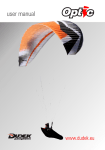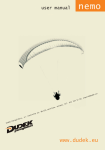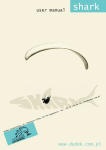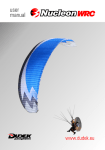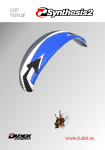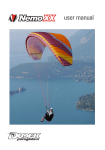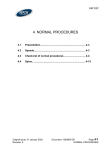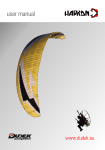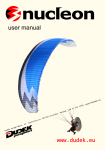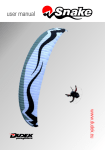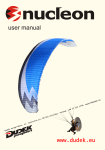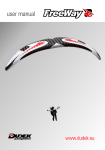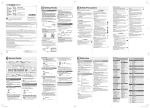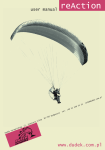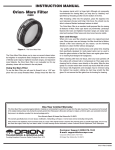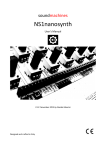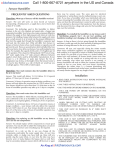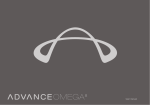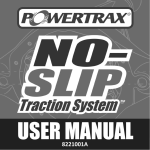Download Untitled
Transcript
TABLE OF CONTENTS Page 1. Introduction .......................................................................................3 2. The wing................................................................................................4 For whom the Optic THE PROJECT DESIGN CLOTH RIGGING RISERS SPEED SYSTEM WHICH HARNESS 3. Flight.....................................................................................................9 PRE-FLIGHT CHECK LAUNCH TURNS THERMALLING AND SOARING FLYING WITH SPEED SYSTEM ENGAGED LANDING WINCHING AND MOTOPARAGLIDING RAPID DESCENDS AEROBATICS WINGOVER EXTREME FLYING MANOEUVRES 4. Canopy care........................................................................................17 STORAGE CLEANING REPAIRS INSPECTIONS DETERIORATION: A FEW TIPS! 5. Technical data.....................................................................................19 6. Warranty, AeroCasco..........................................................................20 7. What have you bought........................................................................22 8. Rigging scheme...................................................................................23 9. Risers: design and accessories .........................................................25 NOTE! Please read this manual before your first flight USER MANUAL 1. INTRODUCTION CONGRATULATIONS! We are pleased to welcome you among constantly growing number of Dudek Paragliders pilots. You've become yet another proud owner of a cross-country/ recreational state-of-the-art paraglider. Extensive development, use of most modern engineering methods and thorough testing resulted in a user friendly paraglider which provides good performance without neglecting the very fun of flying. We wish you a lot of safe and enjoyable airtime with it. DISCLAIMER Please read this manual carefully and note following details: + Purpose of this manual is to offer guidelines for pilots using Dudek wing. By no means it is intended to be used as a training handbook for this or any other paraglider in general. + You may only fly a paraglider when qualified to do so or when undergoing training by an accredited School or Instructor. + Pilots are responsible for their own safety and their paraglider's airworthiness. + Use of this paraglider is solely at the user's own risk! Manufacturer and distributor do not accept any liability. + This paraglider on delivery meets all requirements of the EN-926/1 and 926/2 norms or is certified as airworthy by the manufacturer. Any alterations to the paraglider will render its certification invalid. Note Due to constant perfecting of our designs it is possible that actual paraglider can slightly differ from the one described in manual. In case of any doubts please contact us. 3 2. ABOUT THE WING For whom the Optic? Optic is a three-row cross-country/ recreational paraglider of 5,45 aspect ratio and 51 cells, dedicated for actively flying pilots who wish to advance their skills. For pilots, who seek safety of EN B class while craving for exceptional performance. THE PROJECT Canopy design includes rigid cores (Flexi Edge technology) and mini-ribs on the trailing edge perfectly shaping, smoothing and stabilizing the aerofoil at all speeds. Such technology, transferred from purebred competition wings, combined with three-row rigging brings about enormous margin of passive safety, coupled with outstanding performance. The aerofoil used in the Optic has some reflex traits. The paraglider is resistant to collapses, launches easily and has perfect handling. Especially worth mentioning is its great longitudinal and lateral stability. As in other our paragliders the risers of the Optic constitute a complete, comfortable and carefully thought out control panel, where each instrument is placed exactly where it should be and works as it should. Modern risers of 20 mm width feature ball-bearing SmartPulleys, made on special order and conforming to our indigenous design. Versatile and comfortable TCT handles with Easy-Keeper neodymium magnets can be adjusted to individual preferences. The Optic was extensively tested during many hours of internal tests, performed in wide range of terrrain and weather conditions. As a result you got a paraglider that will easily float in slightest lift, and covering long distances in turbulence typical for a thermally active day won’t bring any problems. Speed-system operation is safe and comfortable even in rough air. Optic has lots of speed, great deal of lift, and generally it simply wants to fly – so don’t be selfish and take it with you for a long XC ;) We are sure the Optic is one of the best canopies in its class. DESIGN Canopy was designed in our CSG (Canopy Shape Guard) system, comprising a number of elements resulting in exceptional coherence and stability of the shape. Below you will find a short description of CSG subsystems. 4 USER MANUAL Optic has an elliptic shape with slightly back-swept wingtips. The canopy is made of doubled cells, with ribs supported by VSS (V-Shaped Supports) system. Such design guarantees that the canopy stays rigid, the upper surface is smooth with correctly reproduced aerofoil, and what is most important we have fewer suspension points (thus reducing overall lines' length and drag). Inside the canopy there is RSS (Reinforcing Strap System) applied on the lower surface. RSS is a ballooning-independent reinforcement system made entirely of paragliding fabric, stiffening and stabilizing the canopy. The aerofoil was perfected with DOA technology (Dudek Optimized Airfoil). It merges all our experiences stemming from previous designs and as a special feature is optimized with dedicated CFD engineering software. The suspension points areas are additionally reinforced with laminated fabric so that loads are equally distributed on three planes: vertically (with the ribs), diagonally (with VSS system) and level through RSS. All crossports have been prepared with application of OCD (Optimised Crossports Design). Carefully designed shapes of the openings and their optimal placement between stress lines guarantee efficient pressure distribution in the canopy and its quick inflation. These openings are scaled together with the ribs, so that their replicability is flawless and they do not disturb the aerofoil in any way. Another feature of the Optic is the Flexi-Egde technology. The leading edge is closed to the airflow, and its precise shape is kept with laminated cloth reinforcements, incorporating synthetic rods. The rods make the leading edge stiffer and smoother, bringing improvements in many areas - from easier inflation, through stiffening the canopy in flight to improved general airflow. The intakes are located on the undersurface in the vicinity of leading edge. Their position was chosen very carefully, so that they got maximum ram effect in possibly many flight situations. The wing tips additionally feature ACS (Auto Cleaning Slots) – as the name suggests, these are dedicated openings automatically removing dirt from inside the canopy. Careful selection of modern fabrics and design solutions brings about great strength and durability of the Optic. All materials used come from marked production batches, and each production step can be verified down to identification of specific worker and controller. 5 Optic is manufactured under new technology, utilizing precision of the laser cutter. All stages of production process take place in Poland under strict supervision of the designer himself, thus ensuring highest European quality. CLOTH Each kind of cloth has its own special qualitites. We merged them so that they blend into a perfect composition. The upper surface is made of 38-gram Dominico Tex cloth. Basically it's a nylon material, covered with PU impregnate. Such covered fabric is not very stiff and - what's most important - has increased tear, stretch and UV resistance. It is not siliconised, so minor repairs can be easily made with self-adhesive strips. Lower surface is made of 34-gram Dominico Tex cloth, contributing to low weight of the canopy. The ribs must be as rigid and stretch-resistant as possible. We found these qualities in Porcher Hard Finish cloth with E29A impregnate (40 g/m2). All suspension points and leading edge reinforcements are made of SR-Scrim fabric. RIGGING Almost all of the Optic lines are unsheathed. Due to low number of the lines we made sure they are strong enough by using Technora cores, featuring high strength and stretch-resistance. The rigging system consists of individual lines looped and stitched at each end. The upper level lines start at the attachment points. Cascade-wise they are joined to main suspension lines, either directly or via middle layer lines. Main lines are attached to the risers with triangular quick links (maillons). To prevent their slipping off, the lines are kept together with a rubber 'O ring' twisted in eight. All maillons are made of corrosion resistant, polished stainless steel, ensuring excellent strength and durability. We use only the best quality, certified maillons by Peguet. Stabilo lines run from the outer suspension points to 6 USER MANUAL the maillons through consecutive cascades as well. The same story goes for the steering lines. They run from the trailing edge through several layers to the main lines, which are lead through the pulleys connected to the rear risers and then fixed to the brake handles. Steering lines do not carry any load. RISERS Optic features three-way risers, equipped with: + ELR (Easy Launch Riser). This is a specially marked A riser (gold ribbon) + speed-system affecting A and B risers when engaged. For quick and easy recognition some of the risers are distinguished with coloured band as follows: A - yellow (used during launch), A’ - blue (used for Big Ears) B - red (used for B-stall) C - grey (needed to keep the glider down in strong wind - aborted launch) Main A row suspension lines connect to an A riser (yellow) and A' (blue). B row and stabiliser lines go to B riser (red) and C lines to C riser (grey) as well as steering lines (through their pulleys). Brake handles are attached to the steering lines at optimal point, guaranteeing safe and effective operation. It is marked black on the main brake line and this setting should not be changed. Fixing brake handles above that point causes permanent braking of the paraglider which can easily lead to an accident. Overly long brake lines are not advised either, as total lack of strain can prove dangerous in some situations. Our newest steering handle used in Optic, besides its attractive, light design, features: + TCT (Triple Comfort Toggle) system, + a swivel to prevent possible twisting of the steering line, + EK (Easy Keeper) system. SPEED SYSTEM The heart of speed system is a line sewn into A riser, running through two pulleys and finished with a loop holding small hook. There you attach the 7 speed bar line. In normal flight all risers have an overall length of 490 mm. Speed system affects risers A (with A') and B. When the bar is being pushed, A and B risers are gradually shortened. C-riser retains its original dimensions. CAUTION: An improperly adjusted speed system renders the certification invalid! Speed system adjustment Most of modern harnesses are equipped with special speed system pulleys and sometimes even its own integrated speedbar. If it's not the case, first you need to have some pulleys attached (at best sewn into harness) in such a way that will allow the pilot maximize the output of his/her legs with correct power vector, without effect of pushing the harness back. The speed system cord must be firmly attached (with bowline or other nonslipping knot) to the speed bar. The other end of the cord must be ran upward through the harness pulleys, to be finished with hooks or small carabiners. Overall length of speed system cord should allow pilot to put his/her feet easily into the bar when in flight, and yet should be short enough to cover the full speed range. Make sure that both cords on the speed bar are equal, as even slight difference can result in constant turning of the paraglider. Test your speed system thoroughly on the ground before flying with it! The maximum action is reached when speed system pulleys touch. Speed system operation Before take-off attach paraglider risers to the harness with main carabiners. Then connect speed system cords with hooks or quick-links. Before launching make sure that speed system is not tangled and runs freely. To use the speed system simply place your feet on the speed bar and push forward in a horizontal plane. If you notice loss of pressure on the bar, it can be a sign of imminent frontal collapse. In this case release the bar immediately. Watch out for such things - quick wits can spare you most collapses and in general you will increase your awareness of the air around you. Speed system operation diminishes your paraglider's angle of attack, so that its airspeed is increased. Yet simultaneously canopy becomes less stable that's why you should avoid using speedsystem in turbulent conditions, close to the ground or near other airspace users! Do not use speed system during extreme manoeuvres! If the canopy does collapse, release the speed bar immediately and correct the situation as usual. 8 USER MANUAL WHICH HARNESS? You can use any certified harness with hang point between 35 cm and 49 cm from the seat (the safest distance being 40 cm). Width between carabiners should be somewhere between 37 cm and 45 cm, still in this case the best option is 40 cm too. Please note that any modification of seat/hang point distance changes the position of the brakes in relation to the pilot's body. You must remember that in each harness your typical steering range will be different. CAUTION! Too tight cross straps can dramatically affect the handling, so tightening them actually may not contribute to higher safety. Have them always tightened just the correct amount. 3. FLIGHT PRE-FLIGHT CHECK A thorough pre-flight check is essential for any aircraft and the Optic is no exception. Having unpacked and laid out the paraglider (in a horseshoe directed against wthe wind) following checks must be made: + canopy, lines and risers condition. Do not launch if the slightest damage is noticed, + the paraglider should be arranged so that the centre section A-lines (yellow risers) will strain earlier that the outer ones (A’ - blue risers). This ensures easy and symmetrical launch, + cells of the center section must be handled with special care, so that leading edge stays taut and even, + all lines and risers should be separated. Make sure they are not tangled and pay special attention to the A-lines, which should run free from the A (yellow band) and A’ risers (blue band) to the canopy, + it is equally important to untangle the brake lines so that they will not catch anything on the ground during launch. They must be firmly attached to the brake handles and run freely through the pulleys to the trailing edge, + make sure the risers are not twisted, + it is very important to check that no lines are looped around the canopy. The so-called ”line-over” may have disastrous consequences during take off. 9 Always put on and fasten your helmet before clipping in to the harness. Check quick links (maillons). Sometimes they can unscrew, especially when the wing is new. Check main carabiners. They must be properly mounted, closed and locked. LAUNCH Classic (forward) launch Should be used with little or no wind. Facing the wind place the risers over your shoulders (A riser must lay on top). Clip it into carabiners and lock them. Grip the brake handles and A-risers (marked with yellow band), holding them at the stitching, just under the quicklinks. Spread out your slightly bent hands, keeping them down and back. All risers but the A should be placed near your elbow joints. Apply some tension to check if the A risers stay on top and the lines are not tangled. Take a step back, bow down a little and run forward. After the initial inflation smoothly move the hands with the risers up and over your head until the wing will be directly above you. Check the wing and let the A risers loose. Pump out possible faults and keep an eye on position of the paraglider. Side drift is corrected best by moving yourself always under center of the canopy (launch space permitting). In order to keep wing in the air the suspension lines must stay taut all the time, so in light winds you will have to run forward. With stronger winds you can control the wing while standing still. When leaving the ground apply some brakes, then release it after gaining some distance from the ground. Keep your hands relaxed. Reverse launch To be used when wind speed exceeds 3 m/s. After clipping the risers into carabiners as for the forward launch, turn back to face the wing, moving one riser group over your head. As a consequence, you will have the risers crossed. Unclip the brake handles from rear risers and grip it outside of the risers without crossing neither arms nor lines. In this way you steer the left side with you left hand and vice versa. Now take corresponding A risers on both sides (still keeping brake handles in your hands). Make sure that the wing inflates symmetrically and the lines are not tangled. Building up tension with a few steps back and simultaneously lifting the A risers (do not pull them towards you) will make the paraglider rise. When it arrives over your head, stabilize it with the brakes, check again if all lines are clear and the cells inflated. 10 USER MANUAL When turning into wind, remember to turn the right way (hint: always do it the same direction) and to keep the lines taut (loaded) at all times. The turn itself should be quick and smooth. While turning you have to release the brake handles and grip them again facing forward. Last check of the wing & free space to launch and off you go, running into wind with eventual light braking when taking off. CAUTION: when deflating the canopy in strong winds (e. g. aborting a launch), use the C risers, not the brakes. Using the brakes in strong wind can lift the pilot up and drag him/her back. TURNS Optic is an agile wing, with smooth reactions to the steering inputs. Handling is actually easy and forces grow proportionally to position of the brakes. Adding some weight shift will make the paraglider turn really quick and tight. The combined technique (weight shifting and brake input) is by far the most efficient method. Turn radius is determined by the amount of inside brake used and weight shift. Additional application a little outside brake after initiating the turn with maximum weight shift increases turn efficiency and the outboard wing’s resistance to collapse (in turbulence, the edge of a thermal etc). In case of necessary turning in confined area at slow speed (e.g. slope soaring), it is recommended to steer the decelerated canopy by loosening the brake at the outside of the turn while applying just a little more brake on the inside. NOTE: when entering a turbulent area you should brake a little to put up the tension. It will allow you to react instantly in case of a problem. CAUTION: Too hard or too quick pulling of one brake can cause the wing to enter a spin. THERMALLING AND SOARING When flying the Optic minimum sink is reached with slight brake pressure applied (10 to 15 cm, depending on pilot’s weight). In turbulent conditions the canopy should be flown with a small amount of brake applied. This improves overall stability by increasing the angle of attack of the canopy. The canopy should neither rock back nor surge forwards, but always stay above the pilot. In order to achieve it, the pilot should accelerate the canopy by letting off the brakes when entering a thermal (according to its strength) and brake it on exiting. This is part of basic active flying that can spare you many potential collapses. 11 When soaring the slope, minimum height of 50 m above the ground is recommended for safety reasons. It is important to comply with air traffic rules, especially when many pilots share airspace close to the hill. The avoidance manoeuvres often happen to be impossible in such conditions. FLYING WITH SPEED SYSTEM ENGAGED When flying into head wind or through sink it is advisable (for the sake of best glide angle) to increase speed, as long as conditions are not too turbulent. Remember that on application of speed system overall angle of attack diminishes and the canopy may tuck easier than in normal flight. The faster is your flight, the more dynamic are tucks and stalls. See "Speed system" section. LANDING The Optic is easy to land. Just make sure that last turn into the wind is done with sufficient altitude, since prior to touch down you should build up speed, fully releasing the brakes. Then flare out at 1 - 2 meters over ground by gently braking. The glider may climb again for a while gaining some height, if too much brake is used. Strong wind landings hardly require braking, if any at all! Use C-risers (coloured grey) to deflate the canopy after landing. Using the brakes will probably result in pilot being lifted and dragged backwards. The final glide of the landing approach should be straight and smooth. Steep or alternating turns can result in a dangerous pendulum effect near the ground. WINCHING AND MOTOPARAGLIDING During tests numerous flights were made with winch start and backpack power units, as these are the only means to gain some height in flatlands. Absolutely no contradictions were found for using OPTIC in such flights. CAUTION During start, especially winched or with a motor, always remember to bring the wing directly over your head. The aerofoil and its angle of attack were arranged so as to give maximum lift coefficient with relatively high safety level. As a result it can stay behind a pilot, if he neglects bringing it directly over head during launch. 12 USER MANUAL RAPID DESCENTS Big Ears You can deflate both wingtips simultaneously pulling down the A' risers (blue ribbon) by approximately 50 cm. It is important not to let off the brake toggles while entering the Big Ears manoeuvre. When folded, paraglider will maintain straight course with an increased sink rate (up to 5 m/sec). The canopy remains controllable with weight shifting. On releasing the A' risers canopy usually reinflates spontaneously, or can be aided by a long pump until the tips get clear. Due to possibility of entering parachutal stall it is advisable to apply speedbar after folding the wingtips, in order to diminish AoA. CAUTION: See PARACHUTAL STALL section. Spiral It is characterized by high sink rate. Significant G-forces, however, make it difficult to sustain a spiral for long, as it can place high loads on the pilot and glider. Never do this manoeuvre in turbulence or at too high bank angles. You have to watch constantly the situation, in order to prevent your spiral from turning into a spiral dive (sink rate over 16 m/s). If the pilot releases inner brake and the wing does not start slowing down, he should assist this process with the outer brake. NEVER DO BIG EARS IN A SPIRAL! Tests have proven that loads in spiral dive can be even higher than those used in certification tests (i.e. 8 G). This can result in structural failure of the glider, as smaller number of lines is taking these high loads. B-Stall To enter a B-stall you have to simultaneously pull both B-risers (red) down by 10 - 15 cm. The wing collapses on its entire span along B-row, the airflow over the top surface will break and the canopy projected surface will be significantly reduced. Forward speed will die and you will be descending almost vertically. Further pulling of the B-risers is not advised, as the wing instability can grow. If the canopy forms a horseshoe with the wingtips in front of you, gently apply both brakes to recover. 13 To exit B-stall risers should be released in a smooth and decisive manner. After quick and symmetrical releasing B-lines the airflow reinstates and the wing surges forward to return to normal flight. Forward dive is not excessive due to high stability of the Optic, so braking is not necessary. CAUTION! See DEEP STALL section. All rapid descent techniques should be drilled in smooth air and with sufficient height only! Full stalls and spins are to be avoided as recovery procedures, since irrespectively of paraglider type they may have dangerous consequences! BY FAR THE BEST TECHNIQUE IS WISE, CORRECT AND SAFE FLYING, SO THAT YOU WILL NEVER HAVE TO DESCEND RAPIDLY! AEROBATICS Optic was not designed with aerobatics in mind. WING OVER You make a wingover by executing a series of consecutive, alternating turns with growing bank angle. Too much banking with some flaws in coordination can evoke pretty dynamic collapse. CAUTION: Steep turn with bank angle over 60 degrees is a prohibited aerobatic manoeuvre! EXTREME FLYING MANOEUVRES CAUTION! EXTREME FLYING MANOEUVRES SHOULD ONLY BE CARRIED OUT DURING SAFETY TRAINING COURSE (INSTABILITY TRAINING) UNDER PROPER GUIDANCE! WHILE PROVOKING OR EXITING REAL SITUATIONS THERE IS A DANGER THAT YOUR ACTIONS WILL PROVE TOO QUICK OR TOO STRONG, SO YOU SHOULD ALWAYS EMPLOY GOOD JUDGMENT, STAY CALM AND TAKE ONLY MEASURED ACTIONS. Since all actions required to exit or prevent dangerous situations on this paraligder are typical and pilots flying this wing should be properly qualified, we are going to describe only the characteristic features of the Optic. Description of standard dealing with extreme situations can be found in textbooks. 14 USER MANUAL SIDE COLLAPSE May happen in strong turbulence. Usually the paralgider does not turn at all. In case of collapses of some 50% pilot has a couple of seconds to react before paraglider enters rotation. A little countermeasure will be enough to keep it on course. Under normal conditions the canopy will reinflate instantly and spontaneously. SYMMETRIC COLLAPSE (FRONTSTALL) Can happen in strong turbulence. Active piloting will usually prevent its occurrence. Optc is a modern paraglider with significantly stiffened leading edge. Tests have shown that most often canopy reinflates spontaneously, however in specific turbulent conditions it is possible that airflow will keep the leading edge collapsed. That’s why an instant pilot’s reaction is advised – a measured braking in the correct moment will greatly speed up the recovery. SPIN AND FULL STALL May occur as a result of serious mistake or intentional action by the pilot. Be careful when flying at low speeds, until you feel familiar and comfortable with new wing steering. Wing recovers spontaneously in initial phase of stall, otherwise use standard procedures. PARACHUTAL STALL Under normal conditions does not occur. If you want to prevent it, stick to a couple of rules: + after B-stall, release the risers quick and evenly. This paraglider does not jump forward excessively. + after Big Ears execution engage speed system. It will increase the sink rate and safety margin, as big ears constitute big aerodynamic brake with significant loss of speed. Nevertheless, if such a situation happens, apply some pressure to speed bar and/or push the A risers forward. LINE OVER (CRAVATTE) As most modern wings do, in order to minimise drag in order to minimise drag it has widely spaced suspension lines and stiff leading edge. That's why 15 it's possible that after some bad collapse a wingtip gets tangled. Usually a couple of stronger pulls with brake will clear things out. If it does not solve the problem, try big ears or pulling down corresponding riser. In case of any doubts pilot should seriously consider throwing the rescue chute. EMERGENCY STEERING In case of malfunction rendering it impossible to control the paraglider with brakes, you can safely steer and land using the C-risers (grey) or stabilo lines. 16 USER MANUAL 4. PARAGLIDER CARE Proper maintenance of the paraglider will greatly enhance its durability FOLDING AND STORAGE Optic features a number of recent technologies, like tensioning the leading edge with a plastic string. That's why the paraglider should be folded with care in order to keep it healthy during transport and storage. Basic rules to be observed when folding: 1. We fold the canopy together on rib-to-rib, cell-to-cell basis (like a harmonium). We don't break the wing in halves, taking the stabilizers towards centre. 2. After creating a package along the maximum chord, we don't roll it, but fold two to three times (depending on the chord length) from trailing to the leading edge. 3. Leadin edge stays on top of the folded canopy. Store the paraglider in a dry space, away from chemicals and UV exposure. Never pack up or store the glider when wet. This shortens the life of the cloth. Remember that wing gets wet even when laying on a green grass in full sun, as the grass evaporate. A good precaution to avoid catching wet and/or UV is to use quickpack after rigging up, when you have to wait in start line. Always dry glider thoroughly before any packing or storage. To avoid excessive paraglider cloth wear, do not pack it too tight. While drying, never expose your paraglider to direct sunlight. Please note that frequent playing with your paraglider on a field or a small hill will deteriorate it quickly due to its repeated rising, falling down and dragging around. CLEANING Clean the paraglider with water and a soft sponge. Do not use any chemicals or spirits for cleaning, as these can permanently damage the cloth. REPAIRS Repairs should be carried out exclusively by the manufacturer, authorised distributor or authorised workshop. It is acceptable to fix minor cloth damages with self-adhesive patches included in the package. 17 INSPECTIONS Full inspection is recommended every 24 months, if not advised otherwise by the inspecting person due to current paraglider condition. Paragliders in commercial use (training and tandem flights) should be undergoing Full Inspection every 12 months (excluding first 24-month period after purchase). Technical inspection is carried out by the manufacturer or authorised person. DETERIORATION: A FEW TIPS! This paraglider is basically made of Nylon, a cloth which - like any synthetic material - deteriorates through excessive exposure to ultraviolet rays emitted by the sun. Hence it is recommended to reduce UV exposure to a minimum by keeping the paraglider packed when not in use. Even when packed in the bag, it should not remain in the sun for long. Suspension lines consist of Technora inner core and polyester sheath. Putting them to excessive loads in flight and folding on the ground should be avoided, as it can cause irreversible damage. Keep the paraglider clean since getting dust in the lines and cloth will reduce their durability. Be careful to keep snow, sand or stones away from entering the cell openings: their weight can slow down or even stall the glider, and sharp edges can damage the cloth! Prevent lines from catching anything as they can get overstretched or torn. Do not step onto lines. Uncontrolled strong wind takeoffs or landings can result in the leading edge of the canopy hitting ground at high speeds, which may heavily damage the ribs and surface cloth. Knots can chafe the suspension and/or brake lines. Check line lengths after tree or water landings, as they can stretch or shrink. A line plan may be obtained from the website or dealer when needed. After landing in water you should check the wing cloth as well, since the wave forces can cause the fabric to distort in specific areas. When taking the wing out of water, always do that by the trailing edge, so that water can flow out freely. After sea landing rinse the paraglider with fresh water. Since salt crystals can weaken the suspension lines even after rinsing in fresh water, you should replace them with new ones immediately after contact with salty water. 18 USER MANUAL 5. TECHNICAL DATA Optic 22_XS 24_S 26_M 28_L 31_XL EN B EN B EN B EN B EN B LTF B LTF B LTF B LTF B LTF B 51 51 51 51 51 Surface area (flat) [m 2] 22,00 24,00 26,00 28,00 31,00 Surface area (projected) [m 2] 19,01 20,74 22,47 24,20 26,79 Span (flat) [m ] 10,95 11,44 11,90 12,35 13,00 Span (projected) [m ] 8,80 9,19 9,57 9,93 10,45 Certification Num ber of cells Aspect Ratio (flat) 5,45 Aspect Ratio (projected) 4,07 Sink rate [m /s] Min = 1,0; trim = 1,1; max = 2,0 Speed [km /h] min = 23; trim = 37; max = 51 Max. cord [cm ] 250,27 261,40 272,06 282,34 297,08 Min. cord [cm ] 50,07 52,29 54,43 56,48 59,43 Distance pilot to w ing [m ] 6,90 7,20 7,50 7,78 8,19 Total line lenght [m ] 243,34 254,17 264,54 274,53 288,86 Weight range [kg] 50-70 60-85 75-100 90-120 110-140 5,0 5,5 5,8 6,0 6,7 Weight [kg] Lines Edelrid 7343-280; A-8000U: 050 & 090 & 120 Fabric Dominico tex 38 g/m2 Dominico tex 34 g/m2 Porcher Hard 40 g/m2 SR Scrim, SR Laminate 180 g/m2 Risers PASAMON - Bydgoszcz, Polska 19 10. Warranty and AeroCasco Purchase of a new paraglider is a serious expense for any pilot. That is why we cover our paragliders with extensive warranties and additionally offer an AeroCasco insurance against damage and repair costs. WARRANTY Dudek Paragliders guarantees free of charge repairs caused by the material or production faults along following scheme: For the free-flying paragliders warranty covers 36 months (3 years) or 300 flight hours (depending on what comes first).If the paraglider is used for powered flights, every hour spent in the air should be counted as two (does not apply to dedicated PPG canopies). For the PPG paragliders warranty covers 24 months (2 years)/200 flight hours (depending on what comes first). For the mountaineering (MPG) and speedflying wings as well as school and profit users warranty covers 18 months (1.5 year)/150 flight hours (depending on what comes first). WARRANTY DOES NOT COVER: $ canopy colour fading $ damage caused by chemicals or salt water $ damage caused by incorrect use $ damage caused by emergency situations $ damage resulting from accidents (airborne or not) WARRANTY IS ONLY VALID IF: $ flight hours are correctly registered in the logbook of the owner (and possible earlier owners), distinctly marking PPG flights, $ the paraglider is handled in accordance with the operating manual, $ the purchaser has not carried out any repair by him/herself (excl. minor repairs with self-adhesive patches), $ carried out any modifications, $ the paraglider can be unmistakably identified $ the paraglider was being inspected according to prescribed timetable. If you have ought your paraglider second-hand, ask its previous owner of the paraglider for a logbooks copy (total of flying hours since the date of first purchase). 20 USER MANUAL AEROCASCO Normal warranty does not cover repairs of damages caused by the user or a third party. As costs of such repairs can be considerable, Dudek Paragliders offer an AeroCasco insurance. It covers a one-off repair of any mechanical damage, no matter how big and whoever inflicted them.The only expenses the purchaser has to pay are shipping costs and so-called share-of-cost amount. AeroCasco can be purchased only for a brand new paraglider (at the paraglider purchase). Its cost is 50 euro. NOTE: AeroCasco is not available for all paragliders (check this before purchase). It can be obtained for privately used wings only. AeroCasco applies only to damages that took place during take-off, flight or landing. Obviously, all faults in the material and manufacturing flaws are covered by normal warranty. When handing the paraglider for the repair you have to present a card confirming its AeroCasco status. After the repair you will have to cover only the share-of-cost value of 50 euro. AeroCasco is valid for one repair only.There is a possibility to extend AeroCasco for one more year. To do this you have to send your paraglider for inspection not later than a year after the date of purchase. Extension fee is 75 euro (incl. inspection). Remember to attach the AeroCasco confirmation on expedition. AeroCasco does not apply to any of the following: theft, colour fading, damage caused by incorrect storage or transport, damage caused by chemicals, salt water and force majeure. 21 Summary: If you respect rules of safe flying and proper glider care, you will enjoy many years of pleasant airtime on your paraglider. Still, you must be aware of present dangers and stand up to them wisely. You must accept the fact that all air sports are potentially dangerous and your actual safety depends solely on you. We insist that you fly safely. This concerns both the weather choice and safety margin during all manoeuvres. FLYING THE PARAGLIDER IS ALWAYS YOUR OWN RESPONSIBILITY. SEE YOU IN THE AIR! 7. WHAT DID YOU BUY Dudek paraglider you’ve bought includes: + Backpack + Transport bag (with your canopy inside). + Paraglider itself (canopy, lines, risers). + Compression strap for tightening up the wing before putting it into a bag. + Windsock. + Pocket with paper work and repair wallet including: ? A piece of self-adhesive fabric for small repairs (10 cm x 37,5 cm). Note this excludes even small rips placed in the vicinity of the stitches – they have to be repaired by an authorised workshop. ? Looped and stitched suspension line. It is equal to the longest line used in the paraglider and has to be used as temporary replacement only. Do not cut it if you have to replace a shorter one, just tie it at the length needed. ? A paraglider passport with entered date of purchase ? and valid technical inspection (please check serial number with the sticker on a wing tip). ? The User Manual you are reading. You will receive some small gifts as well. 22 USER MANUAL 8. RIGGING SCHEME The rigging scheme itself is published on the next page, while tables of line lengths you will find on our website www.dudek.eu Line lengths are measured with specialized, computer-operated device. All lines before cut are stretched with a steady 5 kg load. Thanks to the abovementioned device and proper procedures final tolerance of line lengths does not exceed 0.15%. CAUTION!!! Distances given below are to be understood as distances between connection points. When cutting a line for repairs, 200 mm more must be counted, as on each end a 100 mm stitch is required to fix the loop. The only exception is main steering line (brmain), which is looped at the upper end only, while down there is 200 mm margin left for fastening the brake handle (that means 300 mm more is needed to be cut). Length of the steering line is given for the high hangpoint scenario (i.e. longer lines). For the lower hangpoints line is shorter by some 15 cm (you have to fix the handle higher. 23 24 USER MANUAL 9. Risers and accesories C B A' A steering line pulley covered swivel steering handle Easy Keeper magnets speed system pulleys speed system hooks carabiner 25 Triple Comfort Toggle Neodymium magnet of the Easy Keeper Swivel protects the steering line against twisting half-rigid PVC tube rigid plastic rod slit of the rod exchangeable insert The most soft handle is obtained when no insertion is used. Addressing different needs of our clients we have created a TCT system - Triple Comfort Toggle, making it possible to have your brake handles in rigid, half-rigid or soft configuration without need to purchase additional handles. Easy Keeper Easy Keeper is our indigenous way to hold the brake handles at the risers by using strong neodymium magnets. It keeps the handles firmly at the risers, while both attaching and releasing goes smoothly and easily. The system allows for easy placing the brake handles on risers during flight, when they are not used, thus minimalizing danger of getting them into running propeller. 26 USER MANUAL Speed system influence on the aerofoil Risers neutral (without speed) Full speed Slowest speed, minimum sink, Take off position Increased speed, increased sink All risers neutral at: 490mm C B A' A speed system size 31, 28, 26: A - 335 A’ - 335 B - 385 C - 490 C size 24: A - 380 A’ - 380 B - 415 C - 490 B size 22: A - 410 A’ - 410 B - 435 C - 490 A' A 27 Leading edge Cell Intakes Trailing edge Mini-ribs Ribs Risers Fot. Iwona Dudek Stabilizer V 14.08.2012 MADE IN EUROPE
































